How do you paint comic style or cel shaded miniatures? In this article, Neil Amswych shares his experience as a colorblind miniature painter, and his whimsical comic book style of painting.
Read on to learn tips and insights into painting with a comic book style (e.g., cel shading) that you can use for boardgame miniatures, roleplaying game minis, e.g., Dungeon and Dragons, DnD, Pathfinder, wargaming tabletop miniatures and more.
Embracing the Imperfect and Rejecting the Normal
For the four years that I’ve been painting miniatures, I’ve struggled with one repeated question: “But what color is it?”
As someone who is red-green and also blue-purple colorblind, all my life I’ve sought to avoid a repeat of a humiliating miscoloring incident of my youth.
So, for the first few years, I would email pictures to different painter friends and ask them what Citadel colors to use. Occasionally, I would dare to think, “It’s not that color, that’s not right,” and I’d paint it how I saw it, but usually it was a sort of paint-by-numbers exercise, which ultimately frustrated everyone, particularly them.
How Colorblind Am I?
You know those pictures with dots and differing colors during an eye test? I hate them. I can hardly ever see them and I feel inadequate when I’m asked what they show. The test images are supposed to be colored dots that form numbers, the doctors tell me. But, I don’t see them.
I see color, but find it very difficult to tell the difference between many colors, which is why I usually wear brightly colored clothes. Primary colors are my friends!
As a colorblind miniature painter, I have to write down every paint I use so I can be sure I’m using the same color later. My phone is filled with lists of paints from four years of painting minis.
I also usually avoid mixing paints because I know I’ll probably not be able to match it up later. Sometimes, I’ll try to mix 1:1 and very, very rarely 2:1, but nothing else. I also have to have all my paints arranged in order so that I know whether paints with silly names like Waaagh! Flesh are green or brown. It is also fair to note, I totally doubt everything I do related to color.
How to Start Painting Miniatures with a Comic Style (A New Perspective)
When Hellboy, The Board Game, arrived, I decided to try to paint it in a similar way to how the comics looked. I quickly discovered that it wasn’t possible, since in many Hellboy comics so much of the characters are in shadow and that doesn’t work on a 3D miniature.
Slowly, though, I’ve started to develop a pseudo-Mignola comic style as I paint my way through those minis that uses ink without being oppressively dark.
For the game characters with player cards, I still try to get close to the color, but Hellboy has changed the way I view color. Is Abe Sapien green or blue? The answer is yes! Sometimes he’s green, sometimes he’s blue, sometimes he’s blue-grey, sometimes something else.
This alone gave me permission to use color totally differently, to see things not as they are but as the artist wants to represent them in that frame alone. One moment the sidewalk could be grey, the next black. In this particular comic style, color is used to create impact, not as an accurate representation of what actually is. I started with Hellboy furniture so if I messed it up it wouldn’t affect the characters.
Fun Fact: Cel-shading or toon shading is a non-photorealistic illustration, which is used to make 3D graphics appear flat like in comic books (source).
Using Black Ink for Painting Comic Book Style Miniatures
I still haven’t yet worked out why certain angled black lines work for comic style and others don’t. What makes this cobweb-filled mirror my favorite painted piece of Mythic Games furniture is mainly the lines on the glass that I added.
The thin black outline of the white cobwebs against the (*checks notes*), The Fang-colored glass also helps, of course. But, it’s the diagonal lines that really make it comic-style, as well as the glass is colored in this way in the first place!

As I developed the style, each part of the mini would still be only one color so that as I used ink to create shadows (and ink is essential instead of black paint) if I went wrong I could just paint over the mistake. In time, things became more refined.

Essentially, I would paint, large ink, magnified ink, then tidy up. I have only once used a wash while painting this way, for a tiny part of a miniature that I simply didn’t have a good paint color for. I don’t think washes create shadows in the way that the comic style needs.
RELATED: BEST MAGNIFYING LAMPS FOR MINIATURE WORK

Of all the Hellboy characters that I painted, Abe Sapien and Herman von Klempt are my favorite. The magnified-ink stage on Abe worked perfectly, helping to define parts of the mini without having to resort to long thick lines like those in the initial ink stage. Moreover, the base totally makes the mini.

In this style of painting, the base is essential in showing that it’s a comic. So with this mini, I copied the comic style on the cover of Abe Sapien: The Haunted Boy.
Painting Metallic Surfaces on Comic Style Miniatures
With von Klempt, I wanted to make him seem darker and rougher that the image, so I played with the shadows and ink much more than usual on the miniature. Apart from small guns, this was the first time I had painted a lot of metal in a comic-style mini, and it helped me move away from the colors in the picture and into something bolder. I tended away from greys and into blue-greys for the metal.
RELATED: BEST METALLIC PAINTS FOR MINIATURES AND MODELS
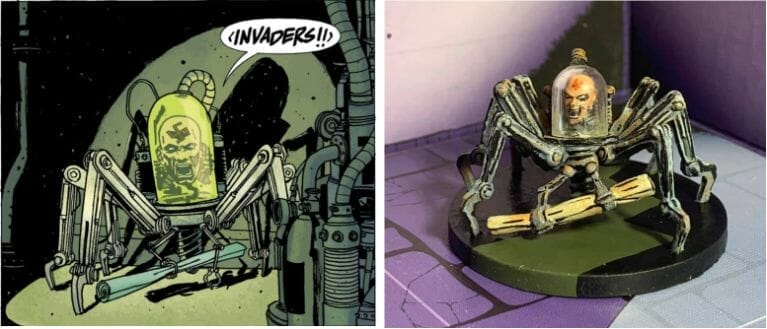
After having churned out 134 Hellboy minis, I started painting Reichbusters minis to use in the forthcoming Hellboy Roleplaying Game because Nazis and monsters!
I deliberately did not look at the Reichbusters cards because their painting style would be different and I need to see each miniature through my pseudo-Mignola comic lens, not their lens. I first picked a miniature with no card: the portal from the Mythic Games Not Of This Earth! Expansion.
While painting this portal, for the first time I started using highlights around the edge of much of the metal. You can see that clearest on some of the clamps around the arch.
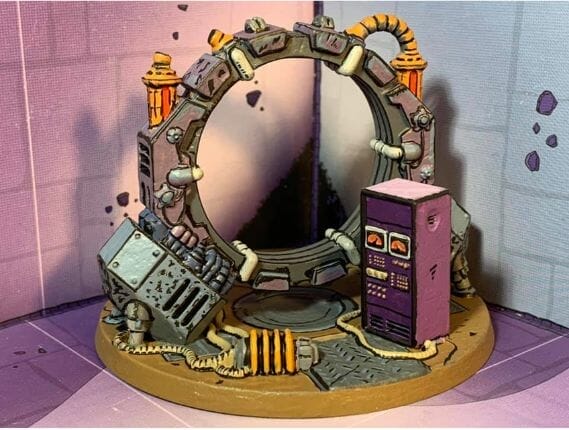
I also discovered by total accident that a good way to do golden metal with shadow in comic style is Deathclaw Brown on top and grey underneath (you can see this on the one remaining pipe on top that I didn’t accidentally break off when I dropped the mini while priming it).
Through this, I learned that shadow in comic style doesn’t have to be in black ink, it can be a cooler color such as Mechanicus Grey. I also learned to do differing colors for metal depending on whether they are (1) above-vertical, (2) vertical, (3) shadowed, and (4) super-shadowed.
With the control box, I inverted the color (what would be light instead became very dark), so that even though the sides were Genestealer Purple and the top Dechala Lilac, the front was Xereus Purple, and this helped the dials and buttons stand out more. Inverting the color at least once can be really helpful to show a comic style.
Recommended Color Choice and Placement for Comic Style Miniatures
I decided to paint a character called General Wolff. It’s a gorgeous mini with mechanical devices (on the rear and his left hand) and a disgusting Nazi squeezed into the unnatural, clattering spooky chariot.
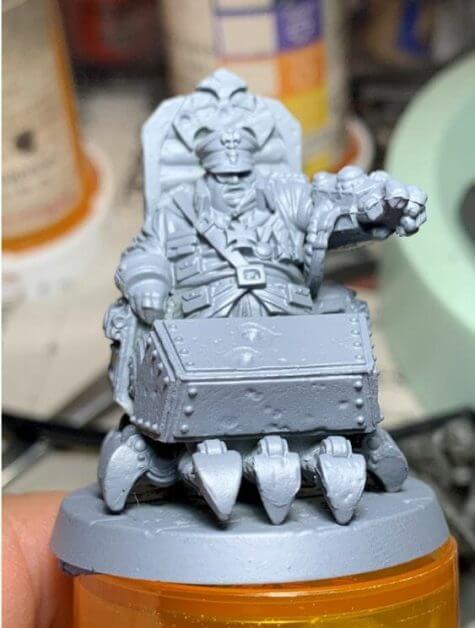
I spent quite a while trying to see it not as something real, but as a comic. Where do I want the most impact to be on the miniature?
I realize that it’s the three cross insignias: one on the chair, one on his hat, and one on his chest. They line up perfectly in the center, so they can stand out.
I start by painting his jacket and hat. I paint the jacket Gorthor Brown and the hat Eshin Grey, and it’s already totally wrong. Gorthor Brown is too light and if I want the cross on his chest to stand out, the jacket needs to be darker. I Google “Nazi Commander uniform,” which, to be fair, is not something I’ve ever Googled before and will probably affect future Google searches in ways I don’t want to consider right now.
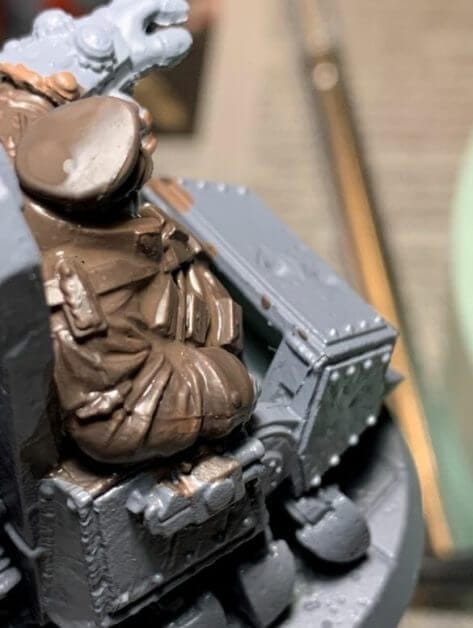
The jacket needs to be dark, but not too dark to show ink later, so I settle for Dryad Bark instead. The gauntlet on his left arm (which is attached to the Vrill tank on the back of the chair) is very Thanos Gauntlet in shape, so I’m definitely not going to paint it with any sense of being golden.
But, I honestly have no idea what to do instead because the metal in the chair is already going to use the following: (1) Above vertical, Russ Grey, (2) Vertical, Daemonette Hide, (3) Shadowed, The Fang, (4) Super-Shadowed, Kantor Blue.
Kantor Blue is a bold choice because it’s not saturated like the other colors, but it allows a crisp difference between the black of the shadow and anything being highlighted in it.
I quickly realize that I’m going to have a challenge painting the inside of the chair, where his legs are tucked. There’s no way I can get a brush in there. So, I take the dropper bottle of ink and just drop a fair amount of ink in the recess under the panel over his legs.
I slowly rotate the miniature to make sure the ink rolls around everywhere and not long later I realize that there is ink all over my hand because the miniature is not watertight! I’ve done the job of filling the space, though, but it’s also a “happy accident” and rather wonderful that I simply never would have planned.

The ink has come out of the corners of the chair and leaked in ways that I never would have considered painting, but which totally work. On the top front panel, there’s a gorgeous triangular shadow that suggests it’s been created by his raised hand. Other parts of the front seem roughly shadowed.
RELATED: THE JOY OF MINIATURE PAINTING
It’s Mignola-style and grungy compared to possible militaristic tidiness. I decide to embrace the imperfect and let it stay as part of the miniature. Later, I’ll add a matching shadow on the left vertical side of the chair.
I paint his belt and hat band with ink and then immediately regret it because ink is only for shadows, not for color. They both become Eshin Grey so that they don’t get pulled into the shadows.
I then paint the feet Mechanicus Standard Grey because I’m planning on doing a similar thing to the tube on the portal, and I dry brush the Deathclaw Brown on a couple as a tester piece but it’s not looking right. This miniature is starting to frustrate me, so I move to another section.
At the back of this gorgeous mini are Vrill containers and I always knew that these would be Mechanicus Standard Grey with Deathclaw Brown.
I had originally considered a light grey, such as Administratum Grey, for the vertical slab with the big cross on the front in a dark color. I realized, though, that this was the main point of color inversion (the other is his legs tucked into the chariot).
By making the slab a darker color, the Deathclaw Brown on the back and the large cross on the front would stand out far more. Naggaroth Night is dark and colorful and as I apply it, I know immediately this is what the miniature needs.
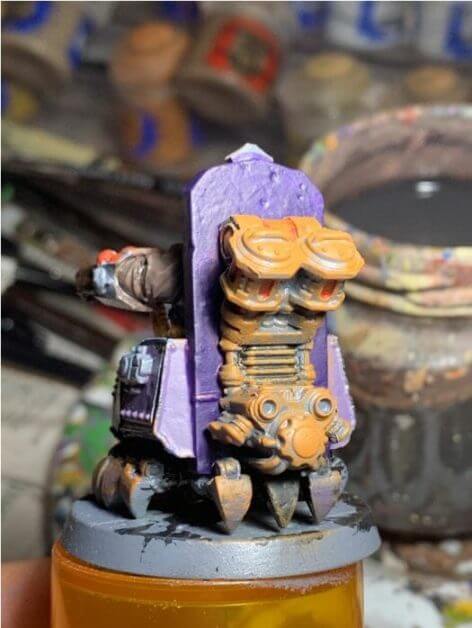
This is the undeniable point of divergence with normal painting: There’s no “But, what color is it?” here!
At first, I ink the outline of the slab, but as I do, I spot my lamplight on the still-wet ink makes it shine and realize that inversion of an object means everything. So instead of a black inked outline, the Naggaroth Night slab ends up with Ushabti Bone edging, which is the most ridiculous edging I’ve ever done, but which totally captures the comic feel. Again, an accident has led me to something very positive!
Now I reach the question I’ve been avoiding. I’ve got two colors for metal and I need a third for the glove, and it can’t hint at golden in any way.
I honestly don’t know what goes through my mind when I reach for the Stegadon Scale Green, because metal isn’t green and I know that. But as I apply the green paint, I realize that it’s just what I needed, especially because it contrasts nicely with the Evil Sunz Scarlet for the Vrill in the glove and the containers.
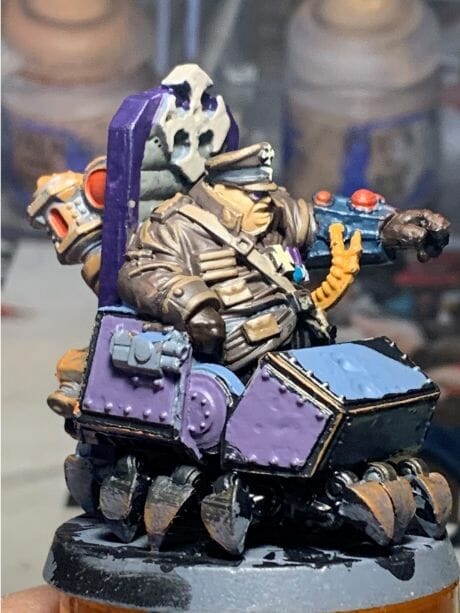
Now I realize I have a good color for the side guns under his arms as well. Suddenly, I’m starting to see this miniature move forward, and I’m liking it. I paint the crosses on his chest in Screaming Skull. I don’t recommend using pure white (though the cobwebs on the mirror miniature shown above were an exception). The cross behind his head I paint slightly darker in Rakarth Flesh to imply some kind of distance.
The padding on the slab is Stormvermin Fur. But instead of putting ink in the horizontal lines, I remember that the whole slab is inverted so I remind myself to paint it in ink with the lines / shadows in Stormvermin Fur. I also start adding Deathclaw Brown to edges at the front so that the shadows aren’t too oppressive on the miniature. It creates stark, bright lines in ways I hadn’t predicted.
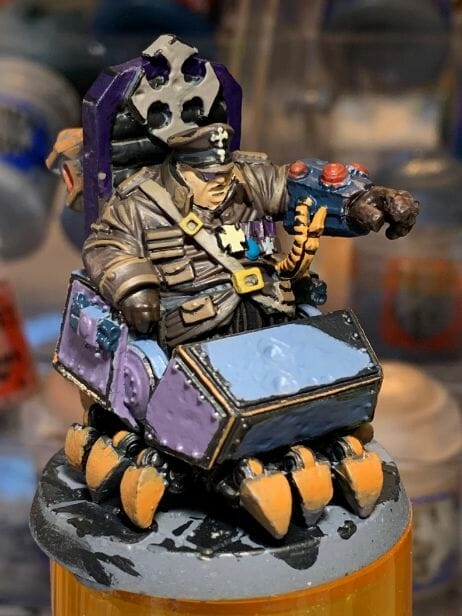
I realize that the mechanical feet need serious work. A light drybrush of Deathclaw Brown won’t work. For the first time with a comic style mini, I apply very thin layers of the color until the very top of each foot is quite strongly colored.
The contrast between the chair and the feet is starting to work and as I ink his body, all the separate parts are starting to stand out against the Dryad Bark uniform.
The gloves are painted in Rhinox Hide, which I’ve never used before for a comic style mini because it’s so dark. But the Rhinox Hide color nicely suggests black while still adding color. In a normal mini painting, I would have used Eshin Grey or Dark Reaper, but that would be boring here. The slab’s padding now has inverted color and that even makes the brown of his uniform stand out.
How to Ink a Painted Miniature for the Comic Book Look
When I ink a miniature, I do it in two stages: first by naked eye, and then with a magnifier. Sometimes by eye can be messy, especially with circles which I always get wrong. In the past, I used to paint over these mistakes but I have come to think that, just like the leaked ink, they’re helpful ways to introduce creative shadowing.
RELATED: BEST DESK LAMPS FOR PAINTING MINIATURES
Here, for example, I clearly went wrong in the first picture, but by the second I used the mistake to feather some shadows to create something that adds to the mini. There’s an important tip here for this Mignola-esque style, which is not to be too tidy, not too organized or too crisp.
Some comic-styles are extremely crisp, but this is not one of them. It’s rough and gritty. I remind myself that even though shadows wouldn’t work here in real life, this isn’t real life. Instead of erasing mistakes, I’m now often using them to paint in ways I hadn’t expected and that seems to work for this style. It’s forgiving.
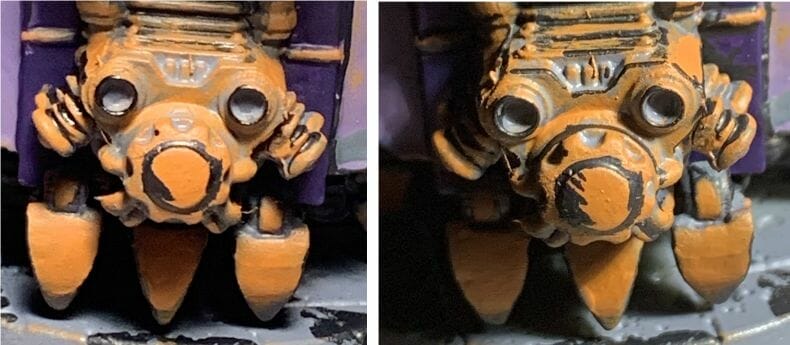
Now the magnifier comes out and I start adding two, three, and four lines on occasional places on the mini. They could be scratches, but I honestly don’t understand why this works in the comic style, but it does. Perhaps it’s because these small lines show that a brush has been here. I try three horizontal lines and it’s ridiculous. There’s something about the angle that works.
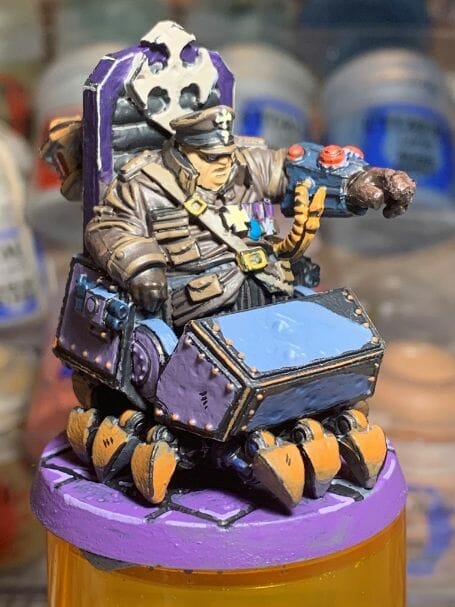
Basing a Comic Book Style Miniature
I color in the paving on the base. Later on, when my son sees the miniature, knowing that I’m colorblind, he gently asks, “Is that meant to be purple?” It is.
I know that paving isn’t purple, but it’s such a gorgeous color that fits nicely with the Deathclaw Brown and the Mechanicus Standard Grey of the feet. To highlight some of the corners and edges of the paving, as well as the mini, I use Dechala Lilac. I leave much under the miniature black ink from where it poured out at the beginning, so that it looks shadowed.
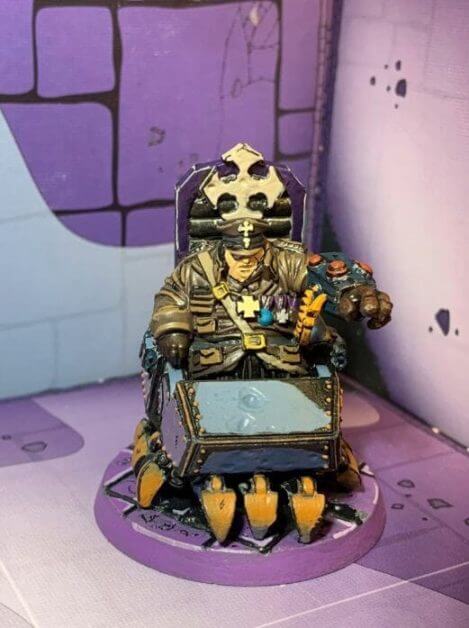
I give the miniature a once-over with the ink, deliberately turning it upside down and using the edge of the brush to ensure that everything that needs an edge has one.

I consider adding highlights to the corners and edges of the metal but realize that the bolts would interrupt it too much, so I decide not to do it at all on the miniature.

After constantly rotating the image and added edging or ink, and Deathclaw Brown on the bolts, General Wolff is done!
15 Tips for Painting Comic Book Style Miniatures
It seems ridiculous to me as a colorblind painter who makes things up as he goes along and who is dwarfed in talent by so many other comic-style painters to be sharing tips to other people. However, if my limited experience can help you, here’s what I have learned so far.
What information can I pass to you from my painting with a Mignola-esque or simple comic style?
Here are 15 tips for painting comic book style miniatures:
- Read the comics. There are so many different artistic styles in Hellboy that you need to choose one and study how it uses shadow and light in particular, then explore how much you can transmit that to a 3D miniature without overpowering it with shadow.
- Focus on where you want the impact to be. Work around this point of interest. This isn’t normal painting and doesn’t need to fit reality.
- Many objects can be monochromatic to provide clear simple comic color, e.g. skin = Kislev Flesh, shoulder strap = Baneblade Brown.
- If you want to blend colors, try using a super soft mascara brush. Where applicable, a spare brush from your partner works well, but only with permission! This soft brush is a lovely way to get colors to blend smoothly. If not, build up many thin layers (check out this article for must-know techniques for blending paint color).
- With metal, choose four colors for above-vertical, vertical, shadowed, and super shadowed. If you’re using grey, consider blue-grey or saturated blues and purples.
- Use black ink, not black paint, and only use it for shadows and nothing else. Shake it properly or it will crack when it dries. Consider a light edge (e.g., the lilac on the base paving) near the shadows if appropriate.
- Once you’ve used ink on all the edges, turn the miniature upside down and do it again because you definitely missed some. Remember that shadows can be important places of inversion, so a very light touch of a color (such as Deathclaw Brown along the edge of the front of the chariot) can be extremely effective.
- If it helps for the impact, invert colors in particular locations by painting something unexpectedly dark yet colorful, inverting the edging to something much lighter, possibly using ink where you would expect color and color where you would expect shadow.
- Use the flat base of a model to provide a 2D “background” to the 3D miniature to really sell the comic style look.
- Don’t use washes. Highlight if you wish, and consider providing some ink that touches some of those highlights.
- Happy accidents. Let them happen and be open minded. Ask yourself if a mistake has actually taken you outside something rigid and has instead opened up the possibility to something else. It won’t always, but it might surprise you, pleasantly.
- Use the three-, four- or five-lined effect. I don’t know why it works, but it does. Keep them at an angle. Because reasons….
- Stay away from metallics and super strong colors and favor saturated colors. Gold can instead be Deathclaw Brown or something similar. Silver can be Russ Grey or something similar.
- Feather the shadows so that they are dynamic things in themselves. At times, a straight line is important for clarity in the miniature. But feathered shadows help draw the eye in even more.
- It’s not about making it real. It’s about making a memorable image. I’m colorblind, so it is easier for me to “see” that pavement can be purple! A metal glove can be Stegadon Scale Green. Although I chose Dryad Bark for General Wolff’s uniform, another artist could have gone with something out of the brown range and done the rest of the mini differently as a result. Color is about perception and the miniature comic style liberates the colorblind painter in particular to not have to think about what color something really is. There’s an element of the actual, and an element of the absurd in comic style and balancing the absurdity with reality makes for a fun painting experience.
Other Examples of Comic Style Painted Miniatures





Final Word
I hope that this article helps you to paint this way, and please feel free to suggest other tips for myself and other painters as well!
You can reach Neil Amswych on Facebook.

Neil Amswych is Principal Rabbi at Temple Beth Shalom in Sante Fe, New Mexico. He also holds a graduate degree in astrophysics, loves all things Star Wars, and his environmental and interfaith work has been mentioned in the Santa Fe New Mexican, the Albuquerque Journal and The New York Times. Neil hosts a brilliant podcast called “Soul Searching“, which you can subscribe to on iTunes and Spotify!
Enjoying Your Visit? Join Tangible Day
Free newsletter with monthly updates (no spam)
Leave a comment below! Follow on X, Instagram, and Facebook.

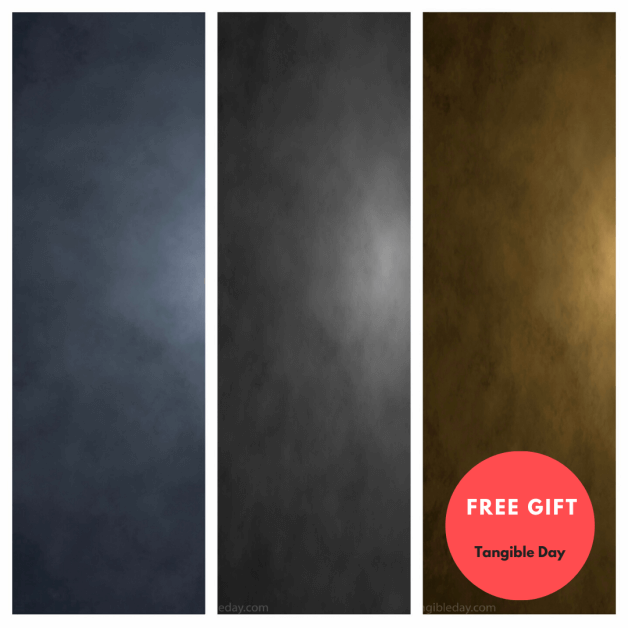
Tangible Day on YouTube (Miniatures and More!)
